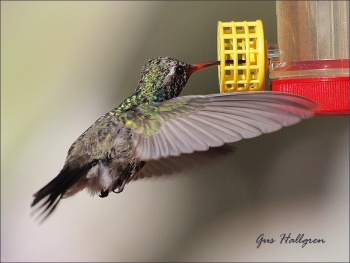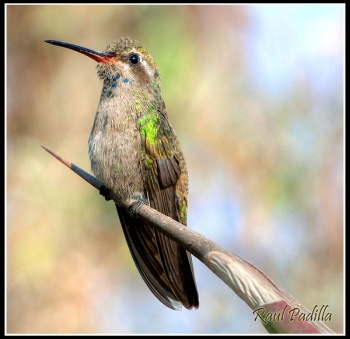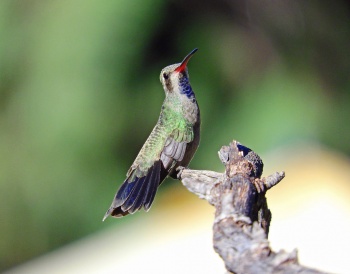(split Tres Marias Hummingbird from this species) |
|||
| (8 intermediate revisions by 5 users not shown) | |||
| Line 1: | Line 1: | ||
| − | [[ | + | [[File:Broad-billed_Hummingbird_LNZ.jpg|thumb|550px|right|Photo © by {{user|Lorenz_C|Lorenz_C}}<br />Phoenix, [[Arizona]], [[USA]], 29 January 2021]] |
| − | |||
| − | |||
;[[:Category:Cynanthus|Cynanthus]] latirostris | ;[[:Category:Cynanthus|Cynanthus]] latirostris | ||
==Identification== | ==Identification== | ||
| − | 9-10cm | + | [[Image:BB F.jpg|thumb|350px|right|Female<br />Photo by {{user|UncleGus_24|UncleGus_24}}<br />Green Valley, [[Arizona]], February 2010]] |
| + | 9-10cm (3½-4 in)<br /> | ||
| + | '''Male''' | ||
| + | *Metallic green upperparts and breast | ||
| + | *White undertail coverts | ||
| + | *Deep blue throat | ||
| + | *Dark, slightly forked tail | ||
| + | *Black-tipped slender red bill<br /> | ||
| + | '''Female''': less colourful, white eye stripe | ||
==Distribution== | ==Distribution== | ||
| − | Southwestern [[United States]] to | + | [[Image:Broad-billed HummingbirdIm.jpg|thumb|350px|right|Immature<br />Photo by {{user|Raul+Padilla|Raul Padilla}}<br />Pachuca, Hidalgo, [[Mexico]], May 2010]] |
| + | Southwestern [[United States]] to central [[Mexico]]. | ||
| + | Accidental vagrant to [[Kansas]]. | ||
==Taxonomy== | ==Taxonomy== | ||
| − | + | [[Turquoise-crowned Hummingbird]] and [[Tres Marias Hummingbird]] were recently split from Broad-billed Hummingbird. | |
| + | ====Subspecies==== | ||
| + | [[Image:Hum-Broad-billed-M-Juv-DSCN3731 copy 2.jpg|thumb|350px|right|Juvenile<br />Photo by {{user|Brian+Hubbs|Brian Hubbs}}<br />SE [[Arizona]], September 2016]] | ||
| + | There are 3 subspecies<sup>[[#References|[1]]]</sup>: | ||
| + | *''C. l. magicus'': | ||
| + | :*Arid south-western [[US]] to north-western [[Mexico]] (Nayarit) | ||
| + | *''C. l. latirostris'': | ||
| + | :*Eastern [[Mexico]] (San Luis Potosí and Tamaulipas to northern Veracruz) | ||
| + | *''C. l. propinquus'': | ||
| + | :*Central [[Mexico]] (Guanajuato to Michoacán) | ||
| + | |||
==Habitat== | ==Habitat== | ||
| − | + | Lower riparian woods, forested mountains (observed to 5500 feet), high desert, oak and Alligator pine, orange groves. Visits garden feeders. | |
==Behaviour== | ==Behaviour== | ||
| − | The female builds the nest in a tree or shrub | + | When perched, the male quivers his tail. often whilst calling. |
| − | + | ====Breeding==== | |
| + | The female builds the nest in a tree or shrub. The clutch consists of 2 white eggs. | ||
| + | ====Diet==== | ||
The diet includes nectar and insects. | The diet includes nectar and insects. | ||
| + | ====Vocalisation==== | ||
| + | '''Call''': They have a loud chittering call which is similar to the call of a [[Ruby-crowned Kinglet]], but more emphatic and without the pauses in the phrasing of the kinglet. | ||
==References== | ==References== | ||
| − | # | + | #{{Ref-Clements6thOct22}}#{{Ref-GillDonskerRasmussen22V12.2}}#{{Ref-HM04}}#{{Ref-SibleyMonroe96}}#Birdforum Member observations |
| − | # | + | #Wikipedia |
| − | # | + | {{ref}} |
| − | |||
==External Links== | ==External Links== | ||
{{GSearch|Cynanthus+latirostris}} | {{GSearch|Cynanthus+latirostris}} | ||
| − | [[Category:Birds]] [[Category:Cynanthus | + | {{GS-checked}} |
| + | <br /> | ||
| + | <br /> | ||
| + | |||
| + | [[Category:Birds]] [[Category:Cynanthus]] | ||
Latest revision as of 01:24, 4 January 2023
- Cynanthus latirostris
Identification
9-10cm (3½-4 in)
Male
- Metallic green upperparts and breast
- White undertail coverts
- Deep blue throat
- Dark, slightly forked tail
- Black-tipped slender red bill
Female: less colourful, white eye stripe
Distribution
Southwestern United States to central Mexico.
Accidental vagrant to Kansas.
Taxonomy
Turquoise-crowned Hummingbird and Tres Marias Hummingbird were recently split from Broad-billed Hummingbird.
Subspecies
There are 3 subspecies[1]:
- C. l. magicus:
- C. l. latirostris:
- Eastern Mexico (San Luis Potosí and Tamaulipas to northern Veracruz)
- C. l. propinquus:
- Central Mexico (Guanajuato to Michoacán)
Habitat
Lower riparian woods, forested mountains (observed to 5500 feet), high desert, oak and Alligator pine, orange groves. Visits garden feeders.
Behaviour
When perched, the male quivers his tail. often whilst calling.
Breeding
The female builds the nest in a tree or shrub. The clutch consists of 2 white eggs.
Diet
The diet includes nectar and insects.
Vocalisation
Call: They have a loud chittering call which is similar to the call of a Ruby-crowned Kinglet, but more emphatic and without the pauses in the phrasing of the kinglet.
References
- Clements, J. F., T. S. Schulenberg, M. J. Iliff, T. A. Fredericks, J. A. Gerbracht, D. Lepage, S. M. Billerman, B. L. Sullivan, and C. L. Wood. 2022. The eBird/Clements checklist of Birds of the World: v2022. Downloaded from https://www.birds.cornell.edu/clementschecklist/download/
- Gill, F, D Donsker, and P Rasmussen (Eds). 2022. IOC World Bird List (v 12.2) DRAFT. Doi 10.14344/IOC.ML.12.2. http://www.worldbirdnames.org/
- Dickinson, EC, ed. 2014. The Howard and Moore Complete Checklist of the Birds of the World. 4th ed. Princeton: Princeton Univ. Press. ISBN 978-0956861122
- Sibley, CG and BL Monroe. 1996. Birds of the World, on diskette, Windows version 2.0. Charles G. Sibley, Santa Rosa, CA, USA.
- Birdforum Member observations
- Wikipedia
Recommended Citation
- BirdForum Opus contributors. (2024) Broad-billed Hummingbird. In: BirdForum, the forum for wild birds and birding. Retrieved 27 April 2024 from https://www.birdforum.net/opus/Broad-billed_Hummingbird
External Links
GSearch checked for 2020 platform.







